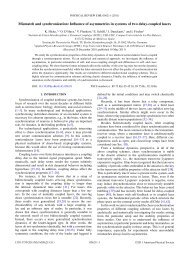DBI Analysis of Open String Bound States on Non-compact D-branes
DBI Analysis of Open String Bound States on Non-compact D-branes
DBI Analysis of Open String Bound States on Non-compact D-branes
Create successful ePaper yourself
Turn your PDF publications into a flip-book with our unique Google optimized e-Paper software.
CHAPTER 3. SUPERSTRINGS 48hence, fermi<strong>on</strong>s. Hence we see that if we keep all states <str<strong>on</strong>g>of</str<strong>on</strong>g> both sectors, we will obtain adifferent number <str<strong>on</strong>g>of</str<strong>on</strong>g> space-time fermi<strong>on</strong>s and bos<strong>on</strong>s, while if space-time supersymmetrywere respected these numbers should be equal. Lucky for us, there is a way to obtainsuch a space-time supersymmetric spectrum, and we will so<strong>on</strong> enough see how. Butfirst, we finish c<strong>on</strong>tructing the unc<strong>on</strong>strainted R spectrum.Apart from the degeneracy in ground states, the spectrum is c<strong>on</strong>structed in the sameway as always. Only this time, we can let the raising operators act <strong>on</strong> several groundstates. We thus find that the first excited level with mass α ′ M 2 = 1 can be reached byapplyingα i −1|a〉 ; α i −1|ā〉 ; b i −1|a〉 ; b i −1|ā〉. (3.45)We thus find that there are 8 × 16 × 2 = 256 states at the first mass level, 128 for eachchirality. The generating functi<strong>on</strong> reads+∞ ∏f R (x) = 16The first few terms in the expansi<strong>on</strong> aren=1( 1 + xn1 − x n ) 8. (3.46)f R (x) = 16x 0 + 256x 1 + 2304x 2 + 15360x 3 + . . .. (3.47)Notice by comparing this to Eq. 3.42 that at corresp<strong>on</strong>ding mass levels, the Ram<strong>on</strong>dsector c<strong>on</strong>tains twice as many states.3.4.2 GSO projecti<strong>on</strong>As we have just seen, the NS sector c<strong>on</strong>tains a tachy<strong>on</strong>, which is something we wouldvery much like to get rid <str<strong>on</strong>g>of</str<strong>on</strong>g>. Not <strong>on</strong>ly that, but moreover there is a different number <str<strong>on</strong>g>of</str<strong>on</strong>g>states in corresp<strong>on</strong>ding mass levels between the NS sector (which are space-time bos<strong>on</strong>s)and R sector (which are space-time fermi<strong>on</strong>s). This is bad, because if supersymmetrywere to be preserved, both numbers would be equal.In order to solve this sneaky problem, we will use an ingenious little sorting device,called the GSO projecti<strong>on</strong>. 6 Looking back at Eqs. 3.42 and 3.47, <strong>on</strong>e sees that it wouldturn out really great if <strong>on</strong>e were to find a way to eliminate the half-integer mass levels<str<strong>on</strong>g>of</str<strong>on</strong>g> the NS sector, and half the states <str<strong>on</strong>g>of</str<strong>on</strong>g> the R sector. This sec<strong>on</strong>d part does not seemtoo complicated; simply project out <strong>on</strong>e <str<strong>on</strong>g>of</str<strong>on</strong>g> both chiralities. For the first requirement,we will need to find a way to separate half-integer from integer mass modes.To reach our objectives, we introduce two operators, <strong>on</strong>e for the NS sector, and <strong>on</strong>efor the R sector, but both resp<strong>on</strong>ding to the name <str<strong>on</strong>g>of</str<strong>on</strong>g> G-parity operator. For the NSsector, we define this operator as 7G = (−1) F+1 with F =∞∑b i −rb i r. (3.48)r= 1 26 Originally introduced by Gliozzi, Olive and Scherk.7 Some references include the “-1” term in the definiti<strong>on</strong> <str<strong>on</strong>g>of</str<strong>on</strong>g> F.
















